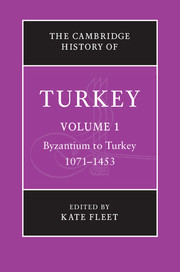Book contents
- Frontmatter
- 1 Introduction
- 2 The Byzantine Empire from the eleventh to the fifteenth century
- 3 Anatolia under the Mongols
- 4 Anatolia, 1300–1451
- 5 The incorporation of the Balkans into the Ottoman Empire, 1353–1453
- 6 Ottoman warfare, 1300–1453
- 7 The Turkish economy, 1071–1453
- 8 Art and architecture, 1300–1453
- 9 Social, cultural and intellectual life, 1071–1453
- Glossary
- Bibliography
- Index
- References
2 - The Byzantine Empire from the eleventh to the fifteenth century
Published online by Cambridge University Press: 28 March 2010
- Frontmatter
- 1 Introduction
- 2 The Byzantine Empire from the eleventh to the fifteenth century
- 3 Anatolia under the Mongols
- 4 Anatolia, 1300–1451
- 5 The incorporation of the Balkans into the Ottoman Empire, 1353–1453
- 6 Ottoman warfare, 1300–1453
- 7 The Turkish economy, 1071–1453
- 8 Art and architecture, 1300–1453
- 9 Social, cultural and intellectual life, 1071–1453
- Glossary
- Bibliography
- Index
- References
Summary
The defeat of the Byzantine armyby the Seljuk Turks at the battle of Malazgirt (Manzikert) in 1071 ushered in a period of military decline, which, despite its fluctuations, culminated with the capture of Constantinople by the Ottoman Turks in 1453. This event brought to an end an empire, which, despite the ethnic, linguistic and religious varieties existing within its borders, in essence had maintained its Graeco-Roman and Christian culture and tradition.
Originally the eastern half (pars orientalis) of the Roman Empire, Byzantium had throughout its existence to defend its territories against forces that rose in the east, west and north. As a result of the migrations of the Germanic tribes, the western half was lost to the empire by the end of the fifth century, despite the subsequent attempts by Justinian I (527–65) to re-conquer these territories. Yet, as long as the empire held on to Asia Minor, its wealthiest province after Egypt in terms of men and resources, it had the possibility of reasserting itself, first against the Persians and later against the Arabs, despite the loss of North Africa, Egypt, Syria and Palestine.
- Type
- Chapter
- Information
- The Cambridge History of Turkey , pp. 6 - 50Publisher: Cambridge University PressPrint publication year: 2009
References
- 3
- Cited by



